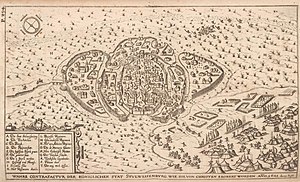Székesfehérvár Basilica
The St. Stephen's Basilica in the Hungarian coronation city of Székesfehérvár was one of the most important churches in medieval Hungary. The church was consecrated to the Virgin Mary , which is why it is referred to as the Marienkirche or the Assumption Church ( Hungarian : Nagyboldogasszony-bazilika ) in Hungary .
Architectural importance
The basilica was built in 1010 under the Hungarian King Stephen the Holy . He had the church built as a three-aisled basilica with four towers. In its time it was one of the most magnificent churches in Europe. With a length of 60 m and a width of 30 m, it had an area of approximately 1,800 m². The domes of Mainz and Cologne at that time were significantly longer (both around 100 m) with the same width. The four papal basilicas in Rome in Rome were twice to four times as large, and the Hagia Sophia in Constantinople had a much bolder construction with a much larger area.
Karl I. Robert had extensive renovations carried out. Markus von Kált writes about it in the Hungarian Chronicle of Pictures (Chronica de Gestis Hungarorum) as follows:
“In the year of the Lord in 1318 the Lord King married Mistress Beatrix , the daughter of the Roman king (...) In the same year the King began to cover the Church of the Blessed Virgin of Alba , which was often ravaged by fire, with a lead roof to let. He decorated this church with a splendid vault, and he also fortified it with strong pillars. "
Political importance
The basilica of Székesfehérvár was the most important site of the medieval Kingdom of Hungary. It housed the crown jewels , which in addition to the St. Stephen's crown also included the throne, as well as the treasury and some archives. 37 kings and 39 queens were crowned in the church, 15 buried in it:
- Stephen the Saint († 1038)
- Koloman († 1116)
- Béla II. († 1141)
- Geisa II. († 1162)
- Ladislaus II. († 1163)
- Stephan IV. († 1165)
- Béla III. († 1196)
- Ladislaus III . († 1205)
- Charles I Robert († 1342)
- Louis the Great († 1382)
- Albrecht II († 1439)
- Matthias Corvinus († 1490)
- Vladislav II. († 1516)
- Ludwig II. († 1526)
- Johann Szapolya († 1540)
The spiritual center of the country was the Archbishopric Esztergom (Gran) .
After large parts of Hungary were conquered by the Turks in 1543, Pressburg Cathedral became the coronation and archbishop's church for the rest of the country, which had become Habsburg .
Desecration and Destruction
The basilica in Székesfehérvár and the royal tombs were looted and served as a warehouse for gunpowder in the Ottoman border town. In 1601 the city was conquered by a Christian army, but fell back to the Ottomans after a few months. That year the basilica went up in flames. A comparison of contemporary representations suggests that the fire, which was probably accompanied by a large explosion, was started by artillery fire from the Christian attackers.
Since then only the foundation walls have been preserved. In 1848 extensive excavations began on the site of the former basilica, which lasted for several decades. In the course of this work, the grave of King Bela III. and his first wife Agnes de Châtillon found. Their bones were recovered and reburied in the Matthias Church in Budapest .
From 1768, the new St. Stephen's Cathedral was built elsewhere in the city in the Baroque style.
literature
- Hungarian illustrated chronicle by Markus von Kalt, (Chronica de Gestis Hungarorum), German edition, Corvina Verlag Budapest 1961
- Ildikó Hankó: A magyar királysírok sorsa ("The fate of the Hungarian royal tombs"), Budapest 1987, ISBN 963-500-613-6 (Hungarian)
Merian : Theatrum Europaeum : “Stulweissenburg” during the temporary reconquest in 1601
N = Exodus of the Turks - almost peaceful
G = “Hauptkirch” - the basilica, without damage
Web links
- szekesfehervar.hu (English)
Coordinates: 47 ° 11 ′ 30.1 ″ N , 18 ° 24 ′ 38.5 ″ E


